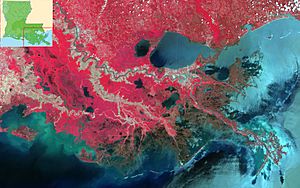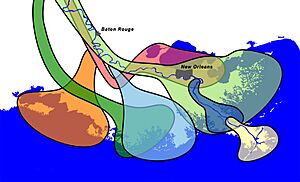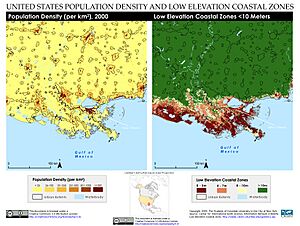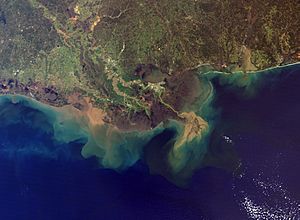Mississippi River Delta facts for kids

The Mississippi River Delta is where the mighty Mississippi River meets the Gulf of Mexico in Louisiana, in the southeastern United States. This huge area of land, about three-million-acre (4,700 sq mi; 12,000 km2) big, stretches along Louisiana's coast. It's one of the largest coastal wetland areas in the country.
The Mississippi River Delta is the 7th largest river delta on Earth. It's super important for the United States. It has over 2.7 million acres (4,200 sq mi; 11,000 km2) of coastal wetlands. These wetlands make up 37% of all the estuarine marsh in the lower 48 states. This coastal area is also the nation's biggest drainage basin. It drains about 41% of the entire United States into the Gulf of Mexico.
Contents
How the Delta Grew Over Time
The Mississippi River Delta we see today formed over the last 4,500 years. The Mississippi River dropped off sand, clay, and silt along its banks. This created new land. The delta's shape, which looks a bit like a bird's foot, shows how powerful the river is.
Before the 1930s, when many levees were built, the river would change its path. It would find a shorter way to the Gulf of Mexico every 1,000 to 1,500 years. These old paths helped create over four million acres (6,200 sq mi; 16,000 km2) of coastal wetlands in Louisiana.
When the river changed course, the flow of fresh water and sediment also changed. This caused some areas to gain land and others to lose it. This process of the river changing its path is called avulsion. It's how the many different landscapes of the Mississippi River Delta were formed.
The Atchafalaya River is the biggest branch of the Mississippi River. It also helps build new land in the delta. This branch formed about 500 years ago. The Atchafalaya and Wax Lake deltas appeared in the mid-1900s.
People have lived in the delta for a long time. They have always faced floods and changes from the river. As more people moved in, they wanted to protect themselves. Starting in the 1900s, new technology allowed people to change the river. These changes helped protect people and grow the economy. But they also had big negative effects on the delta downstream.
The Delta's Geologic History

|
|
Salé-Cypremort | 4,600 years BP |
|
|
Cocodrie | 4,600–3,500 years BP |
|
|
Teche | 3,500–2,800 years BP |
|
|
St. Bernard | 2,800–1,000 years BP |
|
|
Lafourche | 1,000–300 years BP |
|
|
Plaquemine | 750–500 years BP |
|
|
Balize | 550 years |
The Mississippi River Delta started forming about 100 million years ago. This was during the late Cretaceous Period. The river began to drop sediment into the Gulf of Mexico. This started the process of building new land.
The delta grows when the river drops sediment. Then, it eventually finds a shorter path to the sea and leaves its old course. After the river changes, the old delta area starts to lose land. This happens because the land sinks, the marsh shoreline erodes, and sands move around. This natural process of land loss and gain formed the bays, bayous, wetlands, and barrier islands of Louisiana's coast.
The main cycle of the Mississippi River delta began over 7,000 years ago. It formed six major delta complexes. These are large areas of land built by the river. Each complex has smaller parts called delta lobes.
Here are the six main delta complexes:
- The Maringouin delta formed 7,500 to 5,500 years ago.
- The Teche delta formed 5,500 to 3,500 years ago.
- The St. Bernard delta formed 4,000 to 2,000 years ago. The river moved east of New Orleans.
- The Lafourche delta formed 2,500 to 500 years ago. The river moved west of New Orleans.
- The Plaquemines-Balize delta, also called the Bird's Foot Delta, formed over the past 1,500 years.
- The Atchafalaya and Wax Lake Outlet deltas started forming 500 years ago. The Wax Lake Outlet channel was made in 1942 to lower water levels at Morgan City.
People and Culture of the Delta
Delta History
The Mississippi River Delta has a rich history and culture. Spanish explorer Alvarez de Pineda found the mouth of the Mississippi River in 1519. Later, in 1682, Robert Cavelier de La Salle claimed the area for France. The region became important for trade and safety.
In 1699, the French built a fort at La Balize to control river passage. The village was often hit by hurricanes. Ships also struggled with changing tides and mudflats. The main shipping channel changed four times between 1700 and 1888.
In 1803, the United States bought Louisiana from France. New Orleans and the delta became very important for farming. The rich soil from the Mississippi River was perfect for growing sugar cane, cotton, and indigo. These crops were grown before the Civil War. Many of these resources are still important today.
After the Civil War, trade on the Mississippi River grew even more. In the 1870s, old delta swamps were turned into farms using levees. Timber companies harvested trees, and more railroads were built. This helped transport the delta's natural goods.
When the Panama Canal opened in 1914, the Mississippi River Delta became an even bigger trade route. Fishing also grew. Then, large amounts of oil and gas were found. This brought more economic and environmental changes. Even with all these changes, the delta's culture and traditions are still very strong.
Delta People
Over two million people call the Mississippi River Delta home. Its location at the mouth of the river made it a cultural gateway. Many different nationalities settled here over time, creating a diverse region.
In the 1700s, the first settlers were French. Soon, Spanish and Acadian settlers joined them. Later, in the 1800s, other European groups arrived, like Germans, Sicilians, and Irish. There were also Africans, West Indians, and Native Americans. All these groups mixed over time to create the unique culture of the Mississippi River Delta.
Two special groups are the Creoles and the Cajuns. Generally, Creole refers to a person born in Louisiana who might be Black, White, or mixed-race. Creoles came from different ethnic groups mixing in Louisiana. Before 1803, many Creoles were of French or Spanish parents. They kept their European cultures. A group called "Creoles of color" came from African, European, and Native American backgrounds. During colonial times, many mixed-race Creoles were free. They often got an education and owned businesses.
The Cajuns are another group in southern Louisiana. They are mostly descendants of Acadian settlers. These Acadians were forced out of Nova Scotia by the British after the French and Indian War. Cajuns have mixed with all ethnic groups. They have deeply influenced Louisiana's culture. Both Creole and Cajun cultures are very strong in the delta. They shape food, music, and art. Both cultures speak a form of French, but they are different dialects.
Delta Culture
From 1910 to 1920, New Orleans became the birthplace of jazz music. It's still a place for new musicians and music. The Mississippi River and the delta are closely linked to jazz and blues. The delta's location brought in many cultural influences. These included blues and bluegrass from upriver, and African and Latin music from the Caribbean islands. Today, the delta is still known for jazz, funk, and zydeco music. Thousands visit every year to experience this unique culture.
The region is also famous for its food. Cajun food uses ingredients found right in the delta. Spices, shellfish, and grains from the delta's rich environment make these dishes flavorful. Cajun cooking attracts many tourists each year. Its recipes are now enjoyed around the world.
The Delta Today
The Mississippi River Delta offers many natural habitats and resources. These benefit Louisiana and the whole country. The coastal wetlands have diverse landscapes. They connect different habitats on land and in the water.
Louisiana's wetlands are some of the most important natural areas in the U.S. They include natural levees, barrier islands, forests, swamps, and marshes. These areas are home to complex ecosystems. They are vital for keeping the region's unique nature alive. The delta also provides many economic benefits. But these important resources are always at risk due to land loss.
Delta Economy
The Mississippi River Delta has a strong economy. It relies a lot on tourism and fun activities like fishing, hunting, and wildlife watching. Commercial fishing, oil, gas, and shipping are also big industries.
Here are some major industries in the Mississippi River Delta:
- Oil and Gas: About one-sixth of Louisiana's workers are in the oil and gas industry. Louisiana is a key entry point for the nation's oil and gas supply. Port Fourchon in southern Louisiana serves 90% of the offshore oil rigs in the Gulf of Mexico. It provides 16-18% of the country's oil. Louisiana also produces over one-tenth of U.S. natural gas. It has almost 50,000 miles (80,000 km) of pipelines.
- Shipping and Ports: The delta's ports are some of the busiest in the nation. Being at the mouth of the Mississippi River makes them major entry points to the U.S. Five of the largest U.S. ports are in Louisiana, including Baton Rouge and New Orleans. The Port of South Louisiana is the largest U.S. port by weight. It exports over 52 million tons a year. Louisiana's river ports provide about 270,000 jobs. They bring over $32.9 billion to the state each year. The Mississippi River moves about 500 million tons of cargo annually. This includes over 60% of the nation's grain exports.
- Fisheries: Both commercial and recreational fisheries are very important. They provide a way of life for many people on Louisiana's coast. Louisiana has the second largest commercial fishery in the U.S. by weight, after Alaska. The delta has seven of the top 50 seafood ports in the U.S. The Gulf region provides 33% of the nation's seafood harvest. Commercial fishing is a $2.4 billion industry in the Gulf of Mexico.
- Tourism: Louisiana has many things for tourists to enjoy. There are eco-tourism activities like fishing, hunting, and swamp tours. People also love eating at Gulf Coast restaurants that serve local seafood. Thousands of tourists visit each year for the region's unique cultural events. The five Gulf Coast states make about $34 billion annually from tourism. Wildlife tourism alone brings in over $19 billion in spending.
Delta Ecology
The Mississippi River Delta has a very diverse natural environment. It has many wildlife habitats and plants. The delta's coastal landscape is rich in resources. It has some of the most unusual areas in the United States. The delta's wetlands, marshes, and barrier islands also protect coastal residents from storm surges and floods.
- Landscapes – The Mississippi River Delta has many different landscapes:
- Fresh, intermediate, brackish, and saline marshlands make up over three million acres (4,700 sq mi; 12,000 km2) of Louisiana's coast. This is 13% of the state's total land.
- Barrier islands are home to many birds. They are the first line of defense against hurricane storm surge for Louisiana residents.
- Swamps are forested wetlands. The biggest swamp in the delta is 1 million acres. It's in the Atchafalaya Basin.
- Bottomland hardwood forests and maritime forests.
- Beaches.
- Coastal flatwoods.
- Louisiana once had 2.5 million acres (3,900 sq mi; 10,000 km2) of Coastal tallgrass prairie habitat. Much of it has been replaced by cattle ranching and farming.
- Wildlife – The delta's varied landscapes provide homes for hundreds of animals, birds, and other wildlife. Many species are unique to the delta. They rely on the mix of wetland, marsh, and forest ecosystems.
- Many mammals live in the delta's forests, swamps, and estuaries. These include Louisiana black bears, bottlenose dolphins, minks, beavers, armadillos, foxes, coyotes, and bobcats. Some invasive mammals, like nutria and feral hogs, also live here. They can harm native ecosystems.
- The delta is a key stopping point along the Mississippi Flyway. This flyway is one of the longest migration routes in the Western Hemisphere. About 460 bird species have been seen in Louisiana. 90% of them (300 species) are found in the coastal wetlands. Diverse and rare birds like indigo buntings, scarlet tanagers, and bald eagles live here. You can also find great egrets, glossy ibises, and roseate spoonbills.
- Fish – Delta wetlands are important fish habitats. They act as nurseries for many young fish. 97% of the Gulf's commercial fish and shellfish spend part of their lives in coastal wetlands. Some fish found in the delta are speckled trout, redfish, flounder, blue crabs, shrimp, catfish, and bass.
- Endangered and Threatened Species – The Mississippi River Delta is home to several endangered or threatened species. Ongoing land loss and wetland erosion put these species at serious risk. These include:
- Piping plover (a type of bird)
- Kemp's Ridley Turtle (a sea turtle)
- Louisiana black bear
Threats to the Delta
Historically, the Mississippi River Delta naturally grew and shrank. But recently, land loss has happened much faster than land building. This is due to several factors. Some causes are natural, like hurricanes and climate change. However, the delta also suffers from a lack of sediment. This is because of levees, navigation canals, and other man-made structures. These structures slow or stop the river's flow into certain areas. This lets salt water from the Gulf of Mexico enter freshwater wetlands. The salt water weakens these freshwater ecosystems. This makes them more vulnerable to hurricanes and floods.
Natural Threats

- Subsidence: The land in the Mississippi River Delta is sinking faster than in other parts of the U.S. This happens when the river doesn't bring enough new sediment to build up the land. Some researchers think that oil and gas extraction might make this sinking worse.
- Hurricanes and Storms: Coastal wetlands and barrier islands protect Louisiana communities from hurricanes. But as these areas weaken, they become more vulnerable. For example, after Hurricanes Katrina and Rita in 2005, about 200 square miles (130,000 acres; 520 km2) of wetlands turned into open water. This was a permanent loss.
- Sea Level Rise: Sinking land, hurricanes, and rising sea levels all lead to more marsh and wetland loss. As global sea levels rise, parts of the delta that are sinking may flood permanently. The lack of sediment in these flooded areas also makes the effects of sea level rise worse.
Man-Made Threats
- Levees: Levees were built along the river mainly to prevent floods and stabilize the shoreline. This also helped with navigation. Most levees were built after the big river flood in 1927. The Flood Control Act of 1928 started a project to build levees and other structures. This system has been very successful in preventing flood damage. However, this success has come at a high cost for the delta's natural landscapes. Levees cut off the river from the surrounding wetlands. The fresh water and sediment carried by the river are needed for land growth. But levees block this process.
- Navigation, Gas, and Oil Canals: From the 1960s to the 1980s, oil and gas exploration grew in the Gulf of Mexico. Companies dug canals to create deeper channels for ships and pipelines. Over time, 10 major navigation canals and more than 9,300 miles of pipelines were built. These actions directly destroyed wetlands. They also changed the natural water flow, causing more erosion. The canals allow salt water to enter freshwater wetlands. This harms the ecosystems.
The Mississippi River–Gulf Outlet Canal (MRGO) is an example of wetland loss caused by a navigation channel. Built in the 1960s, it destroyed 27,000 acres of wetlands. It also allowed salt water into freshwater areas. It's believed to have acted like a "funnel" for Hurricane Katrina's storm surge. This led to much worse flooding in some areas.
- Upriver Dams: Dams and reservoirs upstream, especially on the Missouri River, have reduced the amount of sediment in the lower Mississippi River. These structures trap the river's land-building sediment. This cuts off the nutrients and minerals needed for the delta's ecosystems. Since the 1950s, these structures have cut the sediment load by almost half.
Restoring the Mississippi River Delta
The Mississippi River took thousands of years to build its delta. But land is being lost much faster now. Many steps have been taken to make coastal Louisiana stronger. Scientists are researching the best ways to restore the delta. Studies show that without new sediment, 4,000–5,000 square miles (10,000–13,000 km2) of the delta could be underwater by 2100. This shows how important restoration efforts are.
Louisiana Coastal Area (LCA) Projects
These projects are part of the Water Resources Development Act of 2007 (WRDA 2007). They allow the Army Corps of Engineers to work on flood control, navigation, and environmental projects. Some important LCA Projects include:
- The Mississippi River Gulf Outlet (MRGO) Ecosystem Restoration Plan: After Hurricane Katrina, the damage from the Mississippi River–Gulf Outlet Canal led to a restoration plan. This plan included closing the channel. It also aims to rebuild habitats like marsh, swamp, and oyster reefs. It uses freshwater diversions and other structures to strengthen the coastline.
- River Diversions: These projects are carefully designed to send sediment to nearby marshes. They also increase freshwater flow. Sediment diversions can create new land and strengthen existing wetlands. Examples in the delta are the West Bay and Mid-Barataria diversions. These are ways to increase sedimentation.
- Redirecting Sediment: The Atchafalaya River Basin has too much sediment. This basin has the largest area of naturally built new marsh in the state. It has been suggested that sediment from the Atchafalaya River could help support the Louisiana coast. The Wax Lake Outlet, for example, has grown every year since 1973.
2012 Louisiana Coastal Master Plan
Louisiana's Coastal Protection and Restoration Authority (CPRA) created a huge plan. It's a $50-billion, 50-year plan to save Louisiana's coast. It was approved in 2012. The plan includes 109 projects. These projects aim to bring long-term benefits to coastal communities and ecosystems. They include restoring water flow, sediment diversions, barrier island restoration, and creating new marsh. Some projects are already happening.
- River Diversions: These projects reconnect the river to the delta. They are designed to copy the natural process of sediment spreading and delta growth. The Mid-Barataria Sediment Diversion is one example. It's in Plaquemines Parish, Louisiana. This project is key to restoring the Barataria Basin. It will help prevent future land loss and protect important ecosystems.
RESTORE Act
The Resources and Ecosystems Sustainability, Tourist Opportunities and Revived Economies of the Gulf Coast States Act was passed in 2012. This law came after the Deepwater Horizon oil spill in 2010. It makes sure that 80% of the fines paid by BP and other responsible parties go to the Gulf Coast. This money is used for environmental and economic restoration.
See also
 In Spanish: Delta del río Misisipi para niños
In Spanish: Delta del río Misisipi para niños




